Alexander 2.3
Alexander the Great (*356; r. 336-323): the Macedonian king who defeated his Persian colleague Darius III Codomannus and conquered the Achaemenid Empire. During his campaigns, Alexander visited a.o. Egypt, Babylonia, Persis, Media, Bactria, the Punjab, and the valley of the Indus. In the second half of his reign, he had to find a way to rule his newly conquered countries. Therefore, he made Babylon his capital and introduced the oriental court ceremonial, which caused great tensions with his Macedonian and Greek officers.
Beginning of the Persian Campaign
To Asia
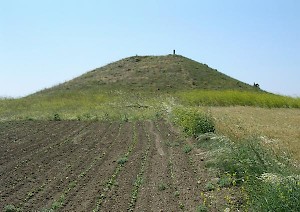
In Asia, the war was not going well. The commander of the Persian mercenaries Memnon of Rhodes had been able to push back Parmenion, but the latter was still in Asia when Alexander crossed the Hellespont with a large army in May 334. Alexander visited Troy, where he and his closest friend Hephaestion seem to have taken part in funeral games for the homeric heroes Achilles - an ancestor of Alexander - and Patroclus. This was the customary thing to do: the Spartan king Agesilaus, who had invaded Asia sixty years before, had done more or less the same (text). From the Trojan temple of Athena, the king took a sacred shield, which saved Alexander's life in India (below).
Meanwhile, the Persian satraps of Cilicia, Lydia, Hellespontine Phrygia and other territories had assembled at Zelea, near Dascylium. They did not know what to do: Memnon proposed to avoid battle and to burn all crops, destroy the grass and horse feed, and even gut the towns. Alexander, who was short of supplies, would be forced to return. Later, the Persian navy could attack the Macedonians at home. This was probably the best idea, but the other commanders agreed that it was better to fight.
The Granicus
Alexander and Parmenion moved in their direction, convinced that it would be an easy battle: after all, the Macedonians were superior in numbers and equipment. In June, the two armies met near the river Granicus (the modern Biga Çay). The Persians had occupied strong defensive positions on one of the banks, which forced Alexander to attack from a difficult angle. Most ancient sources agree that Parmenion advised Alexander not to attack and that it was Alexander's own idea to attack at once.
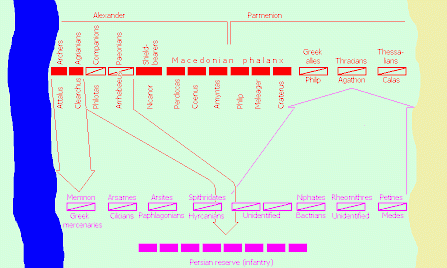
Our sources disagree on what happened next. Diodorus of Sicily writes that Alexander accepted Parmenion's advise; all other authorities agree that the Macedonians attacked immediately. The difference between these sources is that Diodorus uses the now lost History of Alexander by Cleitarchus as his source, and the others are based on the Deeds of Alexander by Callisthenes of Olynthus, Alexander's court historian. Callisthenes had reasons to be hostile to Parmenion, and Cleitarchus' description of the battle is to be preferred. It is probable that the Macedonian king followed the instructions of the experienced general.
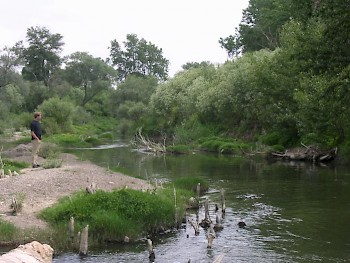
There were good reasons to do so. The Persians never marched before they had made the dawn sacrifices, and this offered the Macedonians a fine chance to move to the other bank during the night. The Persians knew that they did not stand a chance against the Macedonian phalanx, and launched a cavalry charge. They hoped to outflank the Macedonians and attack their rear. However, Parmenion caught their charge. Alexander's archers and Agrianians (light infantry) were sent against Memnon's Greek mercenaries and seem to have prevented this regiment from joining the main battle. The decisive charge was led by Alexander, who, with his Companions, broke through the Persian battle array, in which the Persian cavalry attack had caused a gap. For one moment, Alexander was in danger, but Clitus saved his life. After this charge, the battle was in fact over: the Macedonian phalanx made quick work of the Greek mercenaries (text).
Summer
The official motive for the expedition to Asia was to liberate the Greek cities in the Achaemenid empire and to punish the Persians for the expedition of Xerxes, a century and a half ago. The Greek towns had been liberated before, after the battle of Mycale in 479, but the Persians had reoccupied them when the Greeks were divided (during the Peloponnesian War, 431-404); the Spartans had tried to free them at the beginning of the fourth century, but had negotiated the towns away when they signed a peace treaty with the Persians in 387/386; Parmenion had captured the Greek towns in Asia in 336, but Memnon had reoccupied them. Now that the Persian armies in Turkey had been defeated, it was Alexander's turn to play the role of liberator.
This was, however, less easy than it seemed. To govern these towns, the Persians had made use of the rich local aristocracies; Alexander may have wanted to employ members of the elite too, but could not rely upon them. He was therefore compelled to establish democracies in the Greek towns of Asia (text), an act that was not to win him much approval from his Greek allies, which were mostly oligarchic.
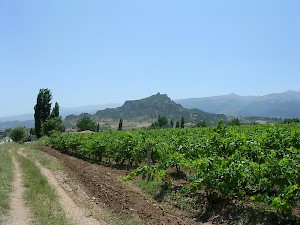
A second, more ominous step was the appointment of satraps. Immediately after the battle at the Granicus, Alexander appointed a Macedonian trustee as satrap of Hellespontine Phrygia, and not much later, Asander, a brother of Parmenion, became satrap of Lydia. This is remarkable: if Alexander wanted to liberate the Greek towns in Asia, there was no need to appoint governors. It meant that Alexander wanted to rule, not to liberate the towns. He also started to levy taxes from the towns, which he called "contributions to the war" - an euphemism for tribute.
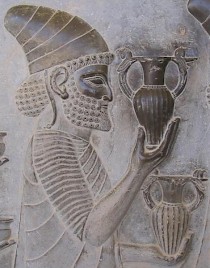
Parmenion captured Dascylium, the capital of Hellespontine Phrygia; our sources say that it fell without struggle, but this is contradicted by the archaeological evidence. After this, Alexander received the surrender of the Lydian capital Sardes, which was proverbially rich. Here he rededicated the temple of Zeus, which the Persians had used to sacrifice to their supreme god Ahuramazda. The future garrison of Sardes consisted of Greek soldiers and it needs to be stressed that this is typical: although Alexander's crusade was presented as a punishment for Xerxes' invasion of Greece, the Greeks played only a minor role. The fighting was done by Macedonians, the Greeks were only used to garrison towns or to guard the lines of communication. And of course, the Greek soldiers were hostages for the good behavior of their home towns.
The capture of Sardes enabled Alexander, who had had to make debts in the year of his accession and, to pay his men. His first gold coins showed an eagle and may commemorate an omen that Alexander received during the siege of Miletus, which followed a month later.
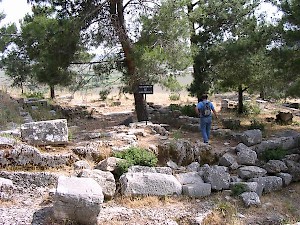
So far, the expedition had been successful, but there were great difficulties ahead. The largest Greek city on the eastern shore of the Aegean sea was Miletus; it had an excellent harbor and the Persians could send in as much men and provisions as they liked, because they had more ships than Alexander. The governor of the city had considered surrender, but when he heard that 400 Persian ships were approaching, he decided to stand his ground. For the first time, Alexander's men faced serious fighting. During this stage of the war, the Macedonian king stayed at Priene, where he founded a new temple.
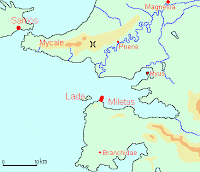
Alexander was lucky: his admiral Nicanor (a brother of Parmenion) occupied the small island Lade with 160 ships. This island commanded the entrance to the harbor of Miletus. Three days later, the Persian navy arrived. But the ships were too late: they could not enter Miletus and were forced to anchor off Cape Mycale, too far to help the besieged town, but close enough to see how Alexander's siege engines made breaches in the walls and how the Macedonians took the city. Now that Miletus had fallen, there was nothing left to do for the Persian navy, and the ships went south to Halicarnassus.